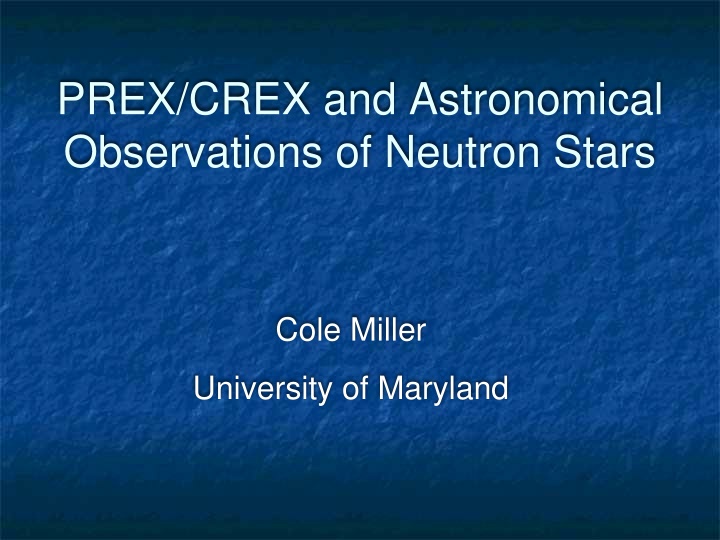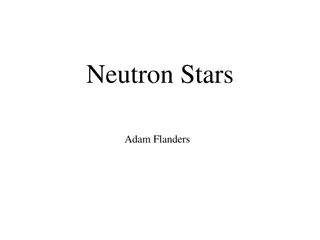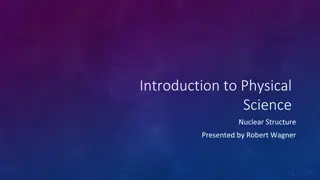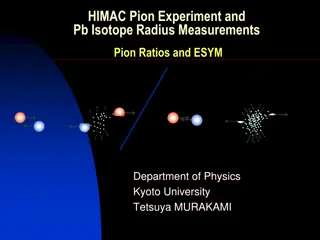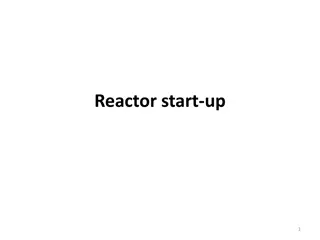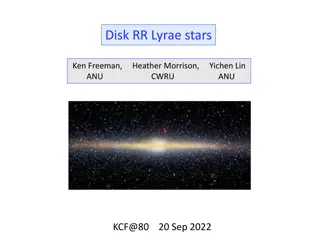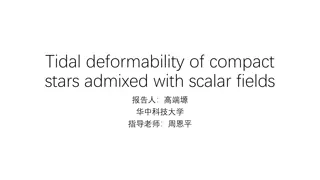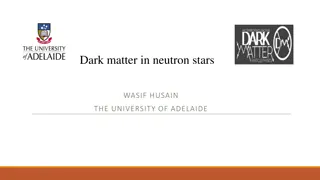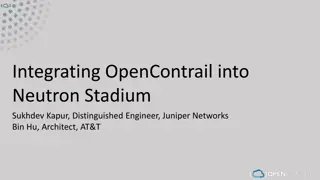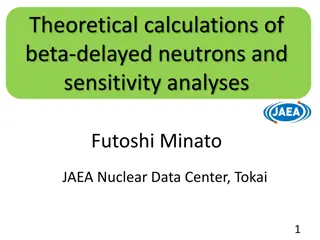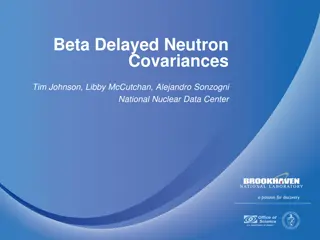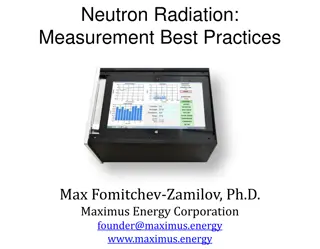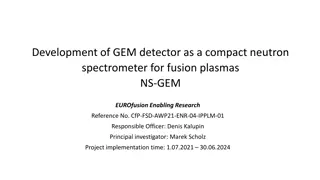Insights into Neutron Stars: Observations and Implications
Exploring the fascinating realm of neutron stars through astronomical observations and the implications for equations of state (EOS). Delve into the mysteries of neutron star properties, measurement results from projects like PREX/CREX, and the significance of NS masses, tidal deformabilities, and radii. Understand the complexities of neutron star core matter, the challenges of composition observation, and the crucial role of EOS in predicting neutron star masses. Unveil the intriguing double neutron star masses and ponder the implications of tightly clustered mass values. Discover the exceptional case of ~2 Msun neutron stars and the breakthrough findings from studies like those by Demorest et al. (2010).
Download Presentation

Please find below an Image/Link to download the presentation.
The content on the website is provided AS IS for your information and personal use only. It may not be sold, licensed, or shared on other websites without obtaining consent from the author.If you encounter any issues during the download, it is possible that the publisher has removed the file from their server.
You are allowed to download the files provided on this website for personal or commercial use, subject to the condition that they are used lawfully. All files are the property of their respective owners.
The content on the website is provided AS IS for your information and personal use only. It may not be sold, licensed, or shared on other websites without obtaining consent from the author.
E N D
Presentation Transcript
PREX/CREX and Astronomical Observations of Neutron Stars Cole Miller University of Maryland
Plan of Talk Why NS are wonderful! Astronomical observations and implications for EOS: NS masses, tidal deformabilities, radii What do PREX/CREX measurements have to say about neutron star properties? NICER results from Miller et al. 2019, 2021; see also Riley et al. 2019, 2021 and Raaijmakers et al. 2019, 2021 2
Why Study Neutron Stars? Frontiers in particle, nuclear, condensed matter, plasma, hydro, QED, and general relativity Figure: Dany Page Core composition is unknown: Nucleons? Hyperons? Quark matter? Let s dive into NS! 3 http://www.astroscu.unam.mx/neutrones/NS-picture/NStar/NStar-I.gif
A Special State Matter in NS cores reaches several times nuclear density It is very neutron rich, unlike nuclei It is also very cold: kT<<EF T~109 K is cold! We can t access this state in laboratories How can NS observations help? And how do the PREX/CREX results improve our understanding of neutron stars? 4
A Confession There is excitement about the composition of NS core matter...but most things we can observe depend only on the equation of state, P( ) An exception might be cooling of NS, but that s difficult to measure at this time and even it doesn t point uniquely to a composition NS measurements that pertain to the EOS include masses, tidal deformability, and radii Let s explore these in turn 5
NS masses A given equation of state (EOS) P( ) (P is pressure, is total mass-energy density) predicts M(R) Assume equilibrium Also predicts maximum mass Viable EOS must accommodate largest measured mass Demorest et al. 2010 6
Double NS Masses Very tightly clustered M=1.35+ 0.1 Msun Does this indicate a very low upper limit on masses? Or are formation conditions just similar? http://www.lsw.uni-heidelberg.de/users/mcamenzi/NS_Mass.jpg 7
~2 Msun Neutron Stars J1614 2230, 1.908+ 0.016 Demorest et al. 2010 J0348+0432, 2.01+ 0.04 Msun Antoniadis et al. 2013 J0740+6620, 2.08+ 0.07 Cromartie et al. 2019 Eliminate EOS that are too soft, i.e., whose pressure is too low at the relevant densities Demorest et al. 2010 8
Gravitational Waves and NS GW come from mass motions, so bulk of NS is involved GW can tell us about cold matter (NS pre-merger) or hot (post-merger, SN) Various quantities matter for different GW observations; all depend on the EOS, so this gives us self- consistency checks Both images from Wikipedia
NS tides from GW Tides take energy from orbit Changes waveform A bigger NS will be deformed more Thus measurement of tidal deformability gives insight into structure For GW170817, no clear evidence for deformation Suggests R1.4<13.5 km Eliminates hardest EOS Simulation: T. Dietrich et al. (Albert Einstein Institute) 10
The Importance of Radii Radius would provide great EOS leverage Wide range in models But tough to measure Measurements that use just flux and spectra are susceptible to huge systematic error One reason: NS atm are fully ionized NICER X-ray pulse modeling can help Demorest+ 2010 11
The NICER Idea in Brief Bayesian fits: trace rays from hot spots on NS surface, compare with energy-dep waveform 12
Mass-Radius Posteriors for J0030 Left: M-R posterior for NICER J0030 data, two ovals Right: M-R posterior for NICER J0030 data, three ovals 13
J0740 NICER+XMM: M and R 10x fainter than J0030; need radio, XMM data as well Radius of PSR J0740+6620: 13.7+2.6 1.5 km (1 ) Dashed line: prior on mass from NANOGrav and CHIME/Pulsar data 14
Information about the EOS Many recent sources of information about dense matter Binding energy of nuclei (~nsat~0.15-0.16 fm-3) PREX/CREX (isospin asymmetry near nsat) cEFT (up to ~1.5-2 nsat) Radius, tidal deformability of 1.4 Msun NS (~2 nsat) Existence, radius of ~2 Msun NS (~4-6 nsat) pQCD (down to ~40 nsat; influence at NS den?) 15
Inferring the EOS Standard approach: assume that we know EOS to threshold density (QHC19, nsat/2~crust/core) Apply a framework for extrapolating to high n We use several; feature Gaussian processes Bayesian analysis, sequence of measurements Prior with framework; pre-NICER (high masses, GW tidal deformability); J0030; J0740 Output is posterior on P vs n, or M vs R 16
J0030, J0740, Other Measurements Provide Tight EOS Constraints Assume knowledge of EOS to half nuclear saturation density, extrapolate using Gaussian processes. Other extrapolations give similar answers. Good EOS convergence in ~ 1.5 5 sat range Cole Miller
Tight Mass-Radius Constraints Sequence: Priors Pre-NICER observations +PSR J0030+0451 +PSR J0740+6620 1 radius 11.8 13.1 km for 1.4 Msun spanning all three EOS models. + 5% Pretty impressive! 18
Impact of PREX/CREX How do the PREX/CREX measurements affect our understanding of NS? In the following we show + 1 range for several quantities. As proxy, we use inferred slope of symmetry energy L(nsat) (Lattimer 2022). L=121+ 47 MeV from PREX; 5+ 40 MeV from CREX; 53+ 13 MeV when both are combined 19
Maximum Mass 22
Conclusions and Future Work Many recent developments in studies of cold dense matter Future astronomical prospects: more tidal deformabilities (LIGO O4 run started in May); better NICER measurements Future nuclear prospects: you tell me! I m excited for the astro/nuclear partnership 24
